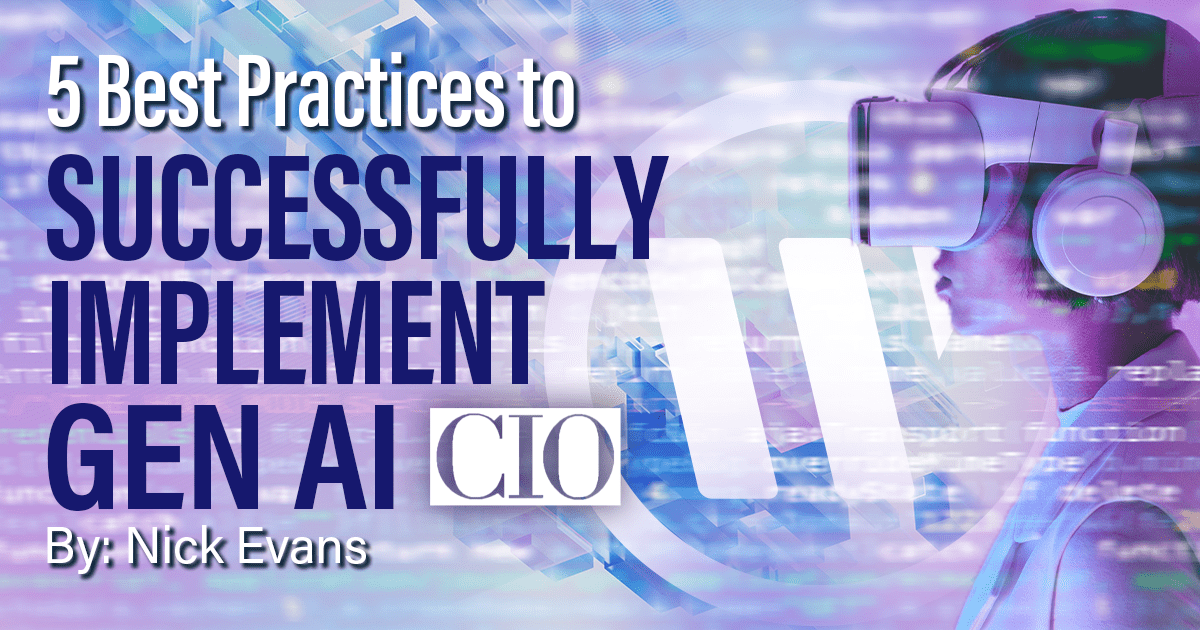
WGI Unleashed Episode 89: Lyndsey Duty, Environmental Scientist
On the latest episode of the WGI Unleashed podcast, we sit down with Lyndsey Duty, one of WGI’s Environmental Scientists based out of our Tampa, FL office!
Learn from award-winning professionals — explore our whitepapers, blogs, and the latest industry updates.
Join our dynamic organization of engineers, land surveyors, landscape architects, environmental scientists, and architects!
Talk to a market leader today! We’ll answer any questions you have about our professional services.

By: Nicholas D. Evans
Implementing this checklist can help you realize the value of an effective gen AI strategy amid all the distractions and foster a culture of strategic investment and innovation.
One of the unusual challenges with gen AI as a technology, however, is it’s currently in mainstream adoption yet still at the peak of the hype cycle. This is why many enterprises are seeing a lot of energy and excitement around use cases yet are still struggling to realize ROI.
So, to maximize the ROI of gen AI efforts and investments, it’s important to move from ad-hoc experimentation to a more purposeful strategy and systematic approach to implementation.
Here are the five best practices to get the most business benefit from gen AI.
Defining a gen AI strategy should connect to a broader approach to AI, automation, and data management. A modern data strategy, after all, needs to address and empower the full IT stack by supporting enterprise objectives for intelligent automation and a myriad of applications supporting transactions, analytics, and decision-making.
Just look at the recently launched EDB Postgres AI, an intelligent platform for transactional, analytical, and AI workloads. Successful AI implementations are 80% reliant on the data side of things, such as quality and hygiene, so you can expect to see even more silo-busting between these types of workloads.
Your strategy should lay out strategic themes around gen AI for the organization and how it’ll support various business objectives. Define which strategic themes relate to your business model, processes, products, and services. Which of these themes support the growth agenda, internal efficiencies, and cost savings? Define how you’ll differentiate, for products and services, your unique value proposition and strategic goals in terms of the outcomes you intend to drive for the business.
There’s likely dozens of use cases for gen AI across your organization, and while many are being identified organically from end users, it’s important to compile a master list. To get a handle on use cases, set up an AI collaboration area on your company intranet and invite practitioners to share what they’re working on and their findings. This helps to inventory activity across the organization and encourages knowledge sharing and coordination. You’ll likely be surprised by the number of use cases actively being evaluated and the participants involved.
By taking the master list of activity underway and then mapping into a customer journey map, or even a process map of your enterprise processes, you can look for gaps and overlaps in coverage, identify further opportunity areas in terms of whitespace, and start to prioritize.
Even if you’re well into implementation on several use cases, an innovation workshop can be a great way to get end users to brainstorm and prioritize use cases. You’ll want to look for both quick wins (high business impact, and high ease of implementation) and must haves (high business impact, but lower ease of implementation due to time, cost, or project risk and complexity), and then add them accordingly to your implementation roadmap.
With gen AI at the peak of the hype cycle, there’s likely a lot of tinkering going on without consistent focus on the end game. However, with a few small modifications, you can harness this energy by encouraging pilots and experiments and empowering end users to be innovators and testers.
To foster a culture of innovation, these small modifications should include providing guidance, support, and encouragement. For example, if end users are trying out a new tool for AI speech-to-text, encourage them to try two or three different tools and compare results. To help them find the best selection for the organization, you can share details of corporate standards, budgetary considerations, and preferred vendors to explore in addition to their current favorites.
As you’re fostering the culture of innovation by encouraging experimentation and pilots, you can help end users navigate the challenges of AI by sharing organizational guardrails.
As mentioned in 4 ways to ask hard questions about emerging tech risks, a simple guardrail at the organizational level is to craft your own corporate use policy, as well as sign on to various industry agreements as appropriate. For AI and other areas, a corporate use policy can help educate users to potential risk areas, and hence manage risk, while still encouraging innovation.
While each industry will have its own priorities in terms of AI risk areas, in the architecture, engineering, and construction industries, we’ve found that data privacy and confidentiality are major concerns. It’s, therefore, useful to educate users on the pros and cons of public versus private GPTs and when to use one, the other, or both. This may impact some of your vendor selections as well. For example, the built-in AI from a long-standing vendor may be the wrong choice if they’re using data from their user community to train their model.
With gen AI, among many other technologies evaluated and used by a broad swath of employees outside the IT department, it’s important to equip them with the tools needed to make their implementations successful for the business.
A key to this is to provide a supporting business case for the use of the technology and how to calculate ROI. In this regard, gen AI is no different from other technologies. It’s a matter of looking at the value proposition and competitive differentiation for client-facing products and services, and the efficiencies in terms of time and cost savings for internal processes. A simple ROI calculation spreadsheet can be a great start and will help employees look at the before and after situation and how gen AI can help streamline operations.
Overall, due to the rapid pace of change in this environment, it’s vital to have an adaptive gen AI strategy, be willing to update it regularly as needed, and pursue continuous learning and improvement across implementations. Take baby steps to get the quick wins and demonstrate ROI early on, but also focus on the must-haves and the more strategic initiatives that will help differentiate your organization in the years to come.
To access the original article, please click here.

WGI is a national design and professional services firm leading in technology-based solutions for the construction of public infrastructure and real estate development. At WGI, we’re providing Tomorrow’s Infrastructure Solutions Today.

On the latest episode of the WGI Unleashed podcast, we sit down with Lyndsey Duty, one of WGI’s Environmental Scientists based out of our Tampa, FL office!

WGI’s San Antonio team laced up their running shoes and braved the rain to take on the iconic Rock and Roll 5K – Discover how they turned challenges into triumphs in this memorable event recap!

With a legacy of supporting, empowering, & inspiring women in transportation, the WTS Central Florida’s Annual Awards & Scholarship Banquet was nothing short of a night to remember.

Discover how Austin is transforming urban development with proposed zoning changes, inclusive housing initiatives, and creative space preservation—all while embracing growth and sustainability.

Texas Medical Center made $78M from parking last year. Why haven’t its busiest garages been upgraded in years?

Discover how WGI helped bring Lively Lane to life—a vibrant community in San Marcos that blends sustainable design, live/work townhomes, and natural beauty to create the perfect balance of urban convenience and serenity.
You’ve been searching for a place like WGI. We look forward to meeting you soon.
Sign up to receive emails to hear our latest news and achievements in our monthly newsletter.
Enter your zip code, and we’ll personalize your experience with local projects, office locations, team members, and more.
WGI supports its associates with meaningful opportunities for growth, strong benefits and perks, while we work collaboratively with clients and co-consultants to shape and improve communities.






WGI is a dynamic organization with opportunities nationwide for engineers, land surveyors, landscape architects, environmental scientists, and architects.